FEATURE ARTICLE: SCOUTING – DEVELOPING LEADERS OF TOMORROW

This article is based on information and images provided by Scouts Australia with the materials being sourced and coordinated be Robert Pitt, Marketing Communications Officer, Scouts Australia.
Australian Scouting is celebrating its centenary year in 2008. To commemorate this and to recognise the contribution that Scouting has made and will continue to make to the Australian community, the Australian Government has designated 2008 the Year of the Scout.
Scouting is the largest youth development organisation in Australia and the world, and is a leader in this country's non-formal education sector.
The Scouting Program delivered by Scouts Australia, prepares young people aged from 6 to 26 years for business and community leadership. There are currently around 60,000 members in Australia - boys, girls, young men and women, and their leaders.
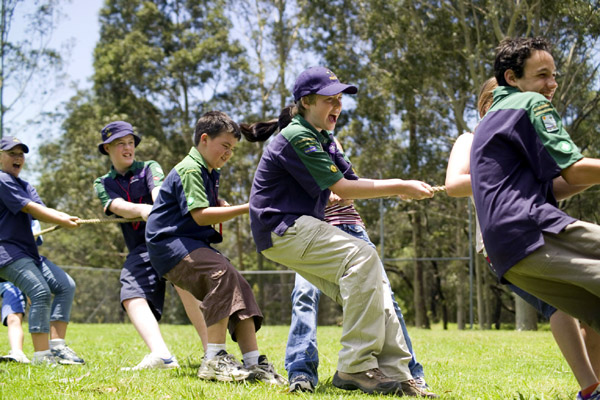 Tug-o-war – courtesy Scouts Australia.
Tug-o-war – courtesy Scouts Australia.
Scouts Australia's aim is to help young people achieve their full potential in life. This is done through individualised, fun, adventurous, challenging, leadership and teamwork-oriented programs. 'Be Prepared', the well known slogan for Scouts, sums up the essence of what Scouting aims to teach young people.
With an emphasis on peace, education and understanding, Scouting transcends all cultures, religions, races, politics, age and gender barriers. Tens of thousands of young people from around the globe meet every four years at World Jamborees to have fun and exchange knowledge and foster understanding. Every day, hundreds of thousands of projects that benefit local communities are conducted by Scouts as they strive to improve the world. The aim of Scouting worldwide can be described as 'educating young people to play a constructive role in society and to create a better world'.
HISTORY OF SCOUTING
Lord Robert Baden-Powell of Gilwell, the founder of Scouting, was born in London, England in 1857. He joined the British Army and was sent to India in 1876 as a young officer. There he specialised in scouting, map-making and reconnaissance. He tried out his ideas of training soldiers in scouting and taught them how to develop experience in stalking and fending for themselves, and to be observant of all signs that would give them an advantage as soldiers.
Following his return to England in 1903, he was encouraged to develop his ideas on how he would apply 'scouting' to the training of boys. In August 1907, he held an experimental camp on Brownsea Island off the Dorset coast. With 20 boys from all walks of life and suitable adult leaders, Baden-Powell taught the boys what he meant by Scouting. They lived in tents, cooked their own food and learnt many valuable skills through games. The camp was a great success and proved Baden-Powell's ideas, so he tackled the task of writing down his experience in a book.
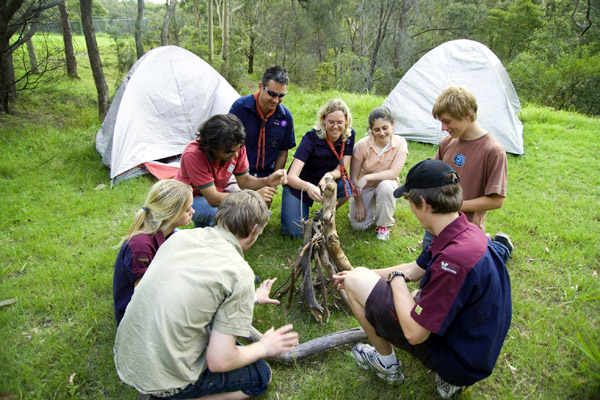 Scouts building a fire – courtesy Scouts Australia.
Scouts building a fire – courtesy Scouts Australia. was first published in six fortnightly parts, beginning in January 1908. Sales of the book were tremendous. Long before the last instalment had hit the book stands, Scout Patrols and Troops had, as if by magic, appeared all over Britain. Baden-Powell finally bowed to the inevitable and accepted that Scouting would have to become a movement in its own right.
Scouting spread to Australia, New Zealand and India in 1908 and other countries followed shortly after. Chile was one of the first countries outside Britain to begin Scouting. In 1910 Baden-Powell visited Canada and the United States of America where it had already started. In 1950, five million Scouts from 50 countries were affiliated with the International Bureau which had been previously created to safeguard Scouting and to prevent control drifting into the hands of the purely religious, political or military bodies. Baden-Powell was acclaimed Chief Scout of the World at the first World Jamboree in London, England in 1920.
Australia was one of the first countries to adopt Scouting. By the end of 1908 Scout Groups had formed throughout many parts of Australia and by 1922 a Federal Council of Scout Groups had been established.
Australia was made a member of the World Organisation of the Scout Movement in 1953. In 1967 the Australian Boy Scouts Association was incorporated by Royal Charter and the name changed to the Scout Association of Australia in 1971. The first Australian Jamboree was held in Melbourne in 1934-35. In 1988, Australia hosted the 16th World Scout Jamboree and the 31st World Scout Conference at Cataract Scout Park, Appin, near Sydney.
Youth members can belong to five Sections:
- Joey Scouts - ages 6-7.5 years
- Cub Scouts - ages 7.5-10.5 years
- Scouts - ages 10.5-14.5 years
- Venturer Scouts - ages 14.5-17.5 years
- Rovers - ages 17-26 years
Adapting to the general changes in Australian society, Scouting admitted girls and young women to its Venturer Scout and Rover Sections in 1973 and its Cub Scout and Scout Sections in 1988. The Joey Scout Section commenced on 1 July 1990 for both boys and girls.
Scouts Australia's structure is a federation of eight state and territory branches and a National Association. The Chief Scout of Australia is traditionally the Governor-General of Australia.
Scouts Australia has actively sought ways for greater community involvement, and various programmes have been developed with organisations such as Rotary and Surf Lifesaving, as well as some state education departments.
CENTENARY OF SCOUTING
World Scouting is governed by the World Organisation of the Scout Movement, based in Geneva, Switzerland. There are national Scout organisations operating in 155 countries with a membership of over 28 million.
World Scouting celebrated its centenary year in 2007. The motto for the centenary was 'One World One Promise' meaning Scouts around the world are part of the same world and take the same Scout Promise. Celebrations were held at national, state and local levels across Australia throughout the year.
The World Centenary had its first major event in Australia with the 21st Australian Jamboree, held at Elmore, Victoria in January 2007. The theme of 'get in the game' emphasised to the 11,000 participants the action-packed nature of the Jamboree with a diverse range of activities on offer such as: abseiling, rock climbing, aquatic activities, learning circus tricks, learning to fly using an onsite air strip, learning to drive, mud-filled games and amusement rides.
 Venturer Scouts hiking – courtesy Neville Austin and Australian Scout Magazine (left). Scouts wading through water in a ravine – courtesy Scouts Australia (right),
Venturer Scouts hiking – courtesy Neville Austin and Australian Scout Magazine (left). Scouts wading through water in a ravine – courtesy Scouts Australia (right),
August 1, 2007 marked the 100th anniversary of the first experimental Scout camp. A worldwide celebration of this historic occasion, called Scouting's Sunrise, was held in which every Scout organisation in the world hosted a function and members re-affirmed their Scout Promise at 8.00 am local time. A traditional Kudu horn, which commenced each day at the first Scout camp on Brownsea Island, was blown at 8.00 am in every Australian state and territory.
The 21st World Jamboree was held at Hylands Park, near Chelmsford, England, from 28 July-7 August 2007, coinciding with the centenary of Scouting. Over 40,000 Scouts attended from many countries around the world. Australia sent 170 youth members and leaders.
As part of celebrations for the World Centenary in 2007 and the Australian Centenary in 2008, the Scouts Reunited website was developed - <http://www.scoutsreunited.com.au>. It enables thousands of past and current Australian Scouts to rediscover their Scouting friends, find out what they have been doing since, and renew acquaintances.
In its centenary year, Australian Scouting is strong with around 60,000 members. Scouts Australia operates through the voluntary efforts of 13,000 leaders and countless other supporters. There are fewer than 100 professional staff, and these are primarily employed in administrative functions.
SCOUTING IN AUSTRALIA TODAY
Scouting Program
The Scouting Program has a flexible range of activities adapted to the needs of the community, and activities are based on the interests of the young people involved with an emphasis on useful skills and service to others. Many Scout activities take place in outdoor settings with a spirit of adventure and challenge. The Australian Scout Program incorporates contemporary issues such as youth health, adventurous activities, vocational skills, the environment, Indigenous Australia and leisurely pursuits.
With a strong sense of responsibility, members can undertake a variety of adventurous activities. Where facilities exist, these include abseiling, canoeing, sailing, white water rafting, scuba diving, rock climbing, caving, canyoning, bush walking, air and alpine activities. Scouts Australia regularly reviews and expands its programmes for young people, continually changing the activities on offer, to keep up with contemporary interests.
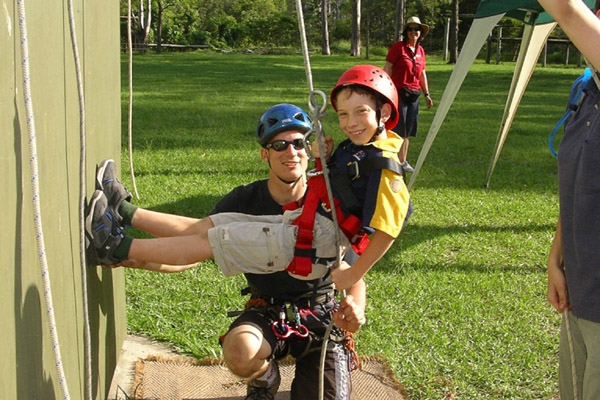 Cub Scout and leader abseiling – courtesy Nick Politylo.
Cub Scout and leader abseiling – courtesy Nick Politylo.
It has developed a programme to foster the development of youth and traditional culture in remote Australian Indigenous communities. The Scouting Program, which commenced in 2002 in Queensland and the Northern Territory, was expanded to other states in 2007.
Leaders and volunteers
Although volunteers run Scouting at all levels, critical aspects at the national level are managed by volunteer National Commissioners who are appointed for specific duties. These appointments include: the Chief Commissioner of Australia; National Commissioner for Youth Program; National Commissioner for Adult Training and Development; International Commissioner; Chair of the National Youth Council (NYC); and Chairman of the National Rover Council (NRC). They are the national managers for their portfolios and coordinate the research, outcomes of reviews and production of programmes in their areas.
The National Executive Committee, its Chairman and members have responsibility for the overall management of the National Association.
All volunteers and professional staff in Scouting work within strict guidelines in regards to their duty of care, and all volunteers and most professional staff are required to personally commit to a formal code of conduct. There is also professional staff and a small number of volunteers delivering and supporting Scout-based youth programmes to secondary colleges in Victoria, South Australia and Queensland.
The Scouts Australia Institute of Training (SAIT) focuses on providing support in the adult training and development areas. SAIT provides support to all training programmes including the accreditation processes for each of the state branches. Each year Scouts Australia delivers more than 1,200 programmes to 10,000 leaders and members throughout Australia. The quality of training courses for older youth members and adult leaders, has long been highly regarded. In 2004 Scouts Australia was registered as a training organisation to deliver nationally recognised leadership of youth training, with several of its courses formally recognised among educational and professional bodies. As such, youth members in some states may have their Scouts Australia courses recorded on their final school results certificates, and adults may benefit in their professional employment. Scouts Australia is continuing to expand its range of accredited courses which now include leadership, business and adventurous activities.
Opportunities for youth
National youth events are held on a rotating basis every three years in Australia for the Scout, Venturer Scout and Rover Sections. National Jamborees of 10,000 or more participants are held for the Scout Section. Australian National Ventures, the equivalent of a Jamboree for teenagers, are held for Venturer Scouts. Australian National Moots are held for the Rover Section.
Youth consultation is a major factor in the operation of Scouting and Australia is a world leader in this area. Young people are included on Scouts Australia management teams at the highest level. As an organisation largely run by adult volunteers, the need to ensure decisions take a youth perspective into account means youth members are included on most decision-making committees such as the National Council, National Executive Committee, National Operations Committee, NYC and NRC.
The NYC comprises 30 youth members from the state branches. They form working groups called Patrols and make recommendations to senior members of Scouting on areas such as the environment; employment, education and training; marketing and communication; and youth and social issues.
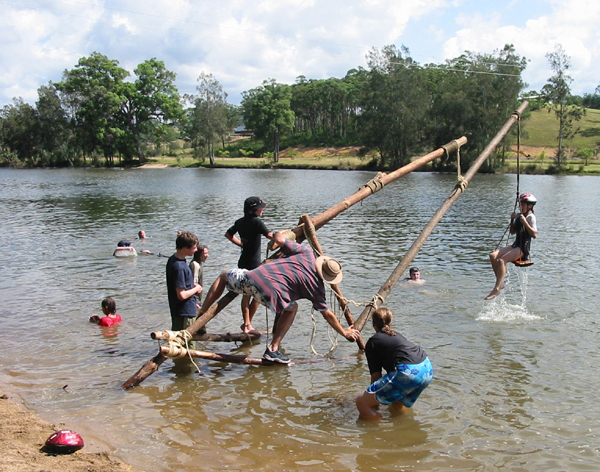 Scouts have fun on a dunking machine they constructed – courtesy Maren Child.
Scouts have fun on a dunking machine they constructed – courtesy Maren Child.
The NRC is the governing body for the Rover Section at the national level. The NRC develops and supports the advancement of the Rover Program and operation of Rovering within Australia. Its executive has youth members on national councils and committees to further add a youth perspective to Scout decision making. Together the NYC and NRC keep a pulse on issues affecting young people both within Australian Scouting and the wider community.
Youth forums are conducted annually - one at each National Jamboree, Venture and Moot. These forums bring together youth members from the same Section with a wide variety of backgrounds, experience and localities, to discuss issues relevant to their age group. They help senior Scout decision makers gain an insight into current issues and feelings on the running of the organisation; and provide fresh new ideas for future developments and decisions.
The Yakkery is a 'drop in' youth forum conducted at some of these events where youth members can 'drop in for a bit of a yack' about issues important to them. It is seen as a way of increasing the scope of engagement with youth members at major national youth events. In the tradition of the Scouting Method, at the 2007 Australian Jamboree, the Yakkery was based around a game that encouraged small groups of Scouts (Patrols) to give their opinion on a range of topics, while having a good time. This method allowed Scouts Australia to engage with some 4,500 youth members over the course of ten days. It was conducted by the NYC whose leadership inspired and encouraged the younger Scouts' interest in youth participation in the decision making of the organisation.
Caring for the environment
From its earliest beginning, Scouting has been involved in the care and exploration of nature as a fundamental aspect of its Program. This is reflected in the Scout Law: A Scout Cares for the Environment.
Scouts Australia provides opportunities to explore and learn about the natural environment and instil in its members a sense of being a 'guardian of the woods', as founder Baden-Powell described it. This is done with a sense of fun and hands-on activities where Scouts 'learn by doing'. Whether playing games or making crafts that re-create Australian animals; going on bush treasure-hunts for natural wonders; photographing or sketching wildlife on a camp; engaging with other groups in major tree planting projects; discovering completely white invertebrates in the darkness of caves; or even participating in environmental workshops or events overseas; the Scouting Program provides a progressive learning opportunity to develop this care for nature.
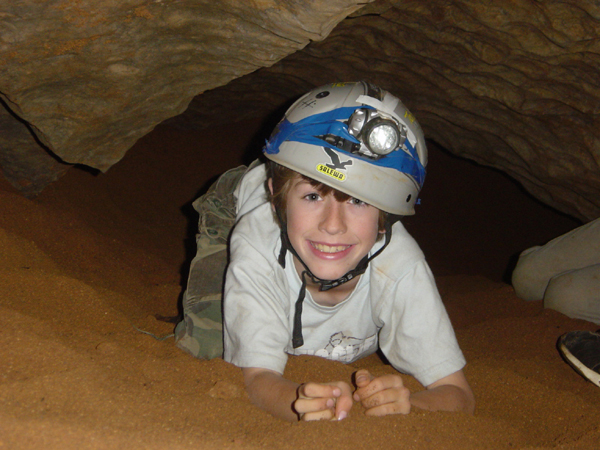 Cub Scout caving – courtesy Robert McKnight.
Cub Scout caving – courtesy Robert McKnight.
All this is emphasised in the award scheme for each Section through the opportunity to achieve badges and awards relating to the environment. Scouts Australia has a National Adviser for the Environment and counterparts in each state. In recognition of Scouts Australia's efforts in this area, the Australian Government announced in 2007 a grant of $17.7 million for the installation of water tanks at Scout halls across the country as a water saving initiative.
International involvement
International Scouting is a dynamic aspect of the Movement experienced by many of its members. Such diverse opportunities range from Jamborees to conferences to camps, just about anywhere in the world. As part of this, Scouts Australia provides many scholarships to overseas events for youth and adult members and has an exchange programme for youth members to live in the United Kingdom, Japan and Denmark. Australia's knowledge and expertise has become increasingly recognised around the world and plays a leading role in the development of Scouting in the Asia-Pacific region in areas such as Youth Program, Adult Training, Finance and Marketing.
Three examples which demonstrate the diversity of international opportunities available to Australian Scouts, beyond the common experience of Jamborees, are:
- A scholarship for two youth members to compete in the Koch Cup sailing event held in the United States of America every two years. Competitors come from many countries.
- In 2006, a team of Australian Scouts won the gold medal at the annual International Space Olympics in Russia, the first time a non-Russian team was successful. The purpose of the event is to stimulate critical and creative thinking skills, and to increase the participants' knowledge of space exploration. The competition was judged by leading Russian scientists and cosmonauts.
- The annual Jamboree on the Air and Jamboree on the Internet involves 500,000 Scouts around the world making contact via amateur radio or the Internet. Through this event, Australian Scouts make contact and lasting friendships with overseas Scouts without leaving home.
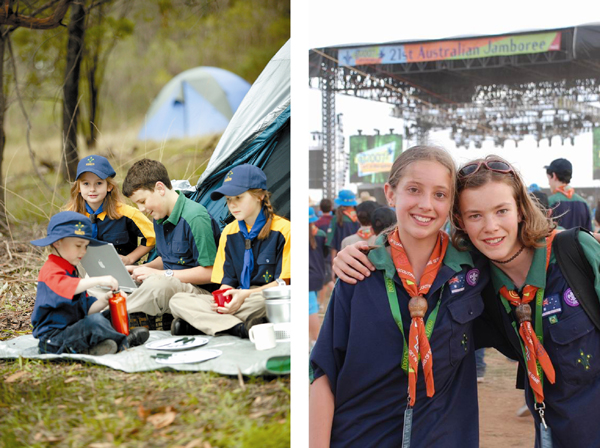 Scouts having fun on a camp – courtesy Snowgum (left). Friends forever – courtesy Tracy Murray (right).
Scouts having fun on a camp – courtesy Snowgum (left). Friends forever – courtesy Tracy Murray (right).
Changing image
In recent years Scouts Australia has focused its efforts on changing what was seen as its 'traditional and regimented' image. That image, and the general trends of busier lives and less community involvement, meant that Scouts has had to work hard to retain its position and to reverse a decline in membership.
As part of a major review to ensure the continuing relevance of Scouting to young people, the current blue uniform was introduced in 2003 to replace the khaki uniform. The core uniform is a dark blue shirt with the relevant youth Section colour across the sleeves, yoke and collar; a blue webbing style belt; scarf and woggle. Scouts may wear neat attire of their choice below the waist, although some Groups or states may specify a style to be worn by their members. The leaders' shirt is dark blue.
Nationwide advertising campaigns conducted over the past few years have presented Scouting as contemporary, exciting and dynamic. Media used include television, local press, bus sides, outdoor billboards and cinema. The 1800 SCOUTS national enquiry number is used on all advertising, as is the national website address <http://www.scouts.com.au>.
The national website serves to promote the benefits of Scouting, as well as keep existing members informed. Scouts Australia also keeps members informed of its achievements and of new and exciting developments via e-newsletters.
A wide range of other strategies have also been conducted at the state level to promote Scouts' visibility in the community and the benefits of Scouting to existing and potential members and their parents. Improved Scout hall signage, school visits and improved parent communication are some of these.
State branches are reporting a halt in the membership decline, with several reporting positive growth over the past year or so. Increased community recognition has seen increased corporate and government support.
Community leaders of tomorrow
Over the 100 years since the Movement was established in Australia more than two million Australians have been involved in Scouts. Many of these have used the skills and confidence gained in Scouts, to achieve success in their chosen professions, others have become leaders in the community. Scouts Australia has taught young people resourcefulness, self-reliance, leadership, decision making, and concern for their community and the environment. In addition, many thousands of young Australians have been given the opportunity for new and unique experiences and challenges, some of which have led to new careers or interests. Above all, Scouts Australia continually provides the community with young Australians who have a greater range of skills, understanding, knowledge and leadership than normally gained through regular formal education systems.
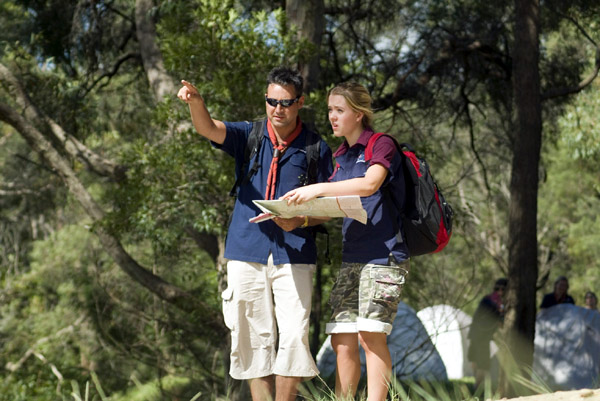 Navigation – courtesy Scouts Australia.
Navigation – courtesy Scouts Australia.
Key events in a century of Scouting
1907 - Scouting starts in the United Kingdom
1908 - Scouting starts in Australia
1912 - Founder, Robert Baden-Powell, comes to Australia for the first time
1919 - Baden-Powell conducts the first training program for Scoutmasters at Gilwell Park, England
1922 - Federal Council of Australian Scout Groups established
1931 - Lord Baden-Powell comes to Australia
1934-35 - Lord Baden-Powell attends first Australian Jamboree
1953 - Australia made member of the World Organisation of the Scout Movement
1967 - The National Organisation was incorporated by Royal Charter
1971 - Name of the Association changed to Scout Association of Australia
1973 - Australia admits girls and young women into its Venturer Scout and Rover Sections
1979 - Formation of National Rover Council
1988 - Australia admits girls into its Cub Scout and Scout Sections
1988 - Australia hosts 16th World Scout Jamboree and 31st World Scout Conference; 14,000 Scouts from Australia and overseas attend the Jamboree at Cataract Scout Park near Sydney
1990 - Joey Scout Section commenced 1 July, enrolling both boys and girls
2001 - Formation of National Youth Council
2003 - Current blue uniform introduced to replace khaki uniform
2004 - Scouts Australia registered as a training organisation to deliver nationally recognised leadership of youth training
2007 - World Centenary of Scouting -- motto 'One World One Promise'; 170 Australians attend the World Jamboree in the United Kingdom as part of Centenary celebrations
2008 - Centenary of Australian Scouting; declared Year of the Scout by the Australian Government
WEBSITES
Scouts, last viewed September 2007
<http://www.scout.org>
Scouts Australia, last viewed September 2007, <http://www.scouts.com.au>
Scouts Reunited, last viewed September 2007 <http://www.scoutsreunited.com.au>
 Print Page
Print Page